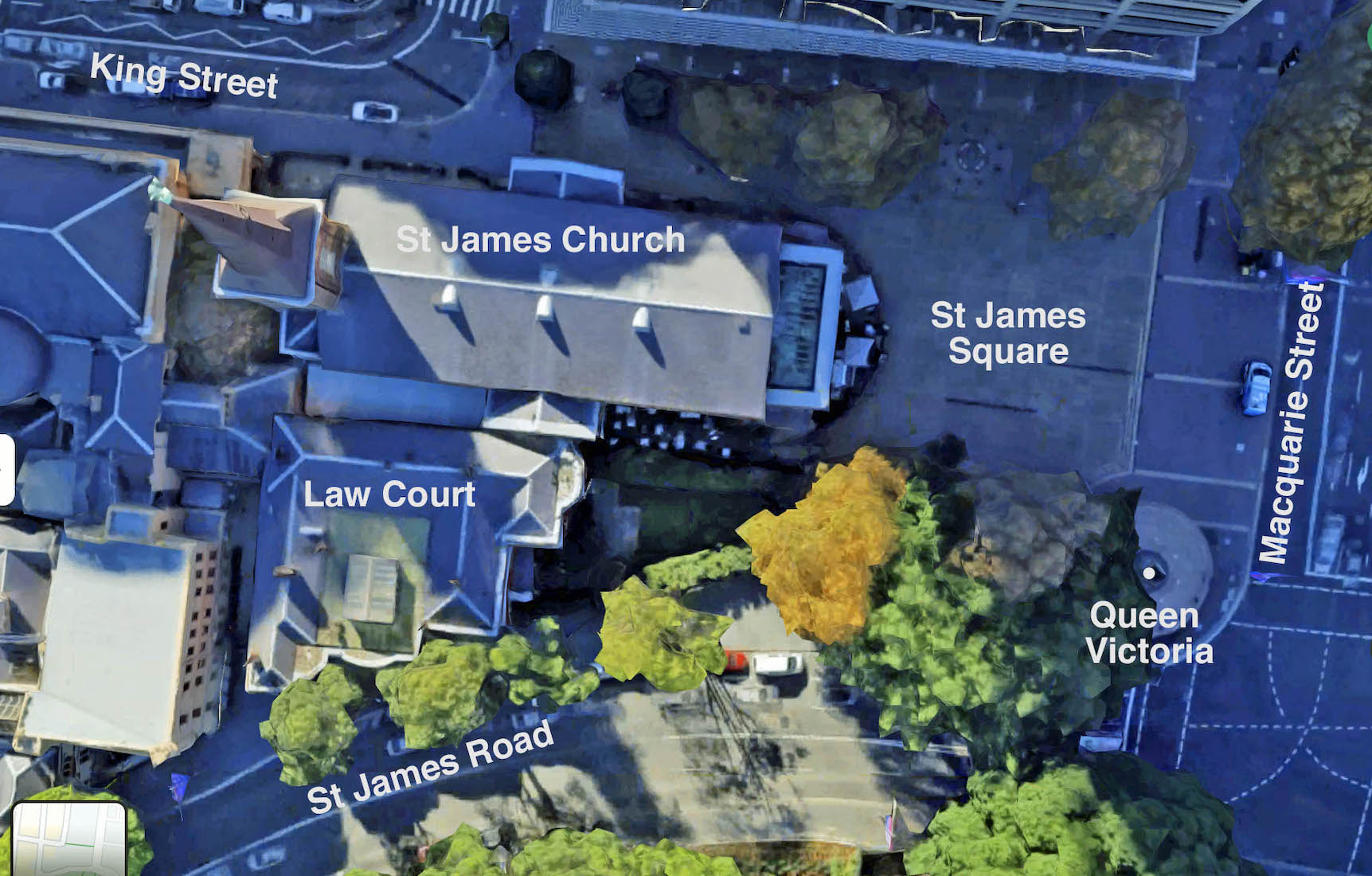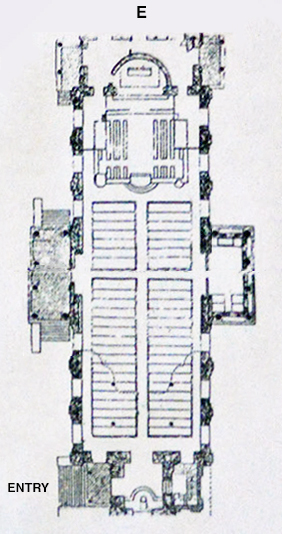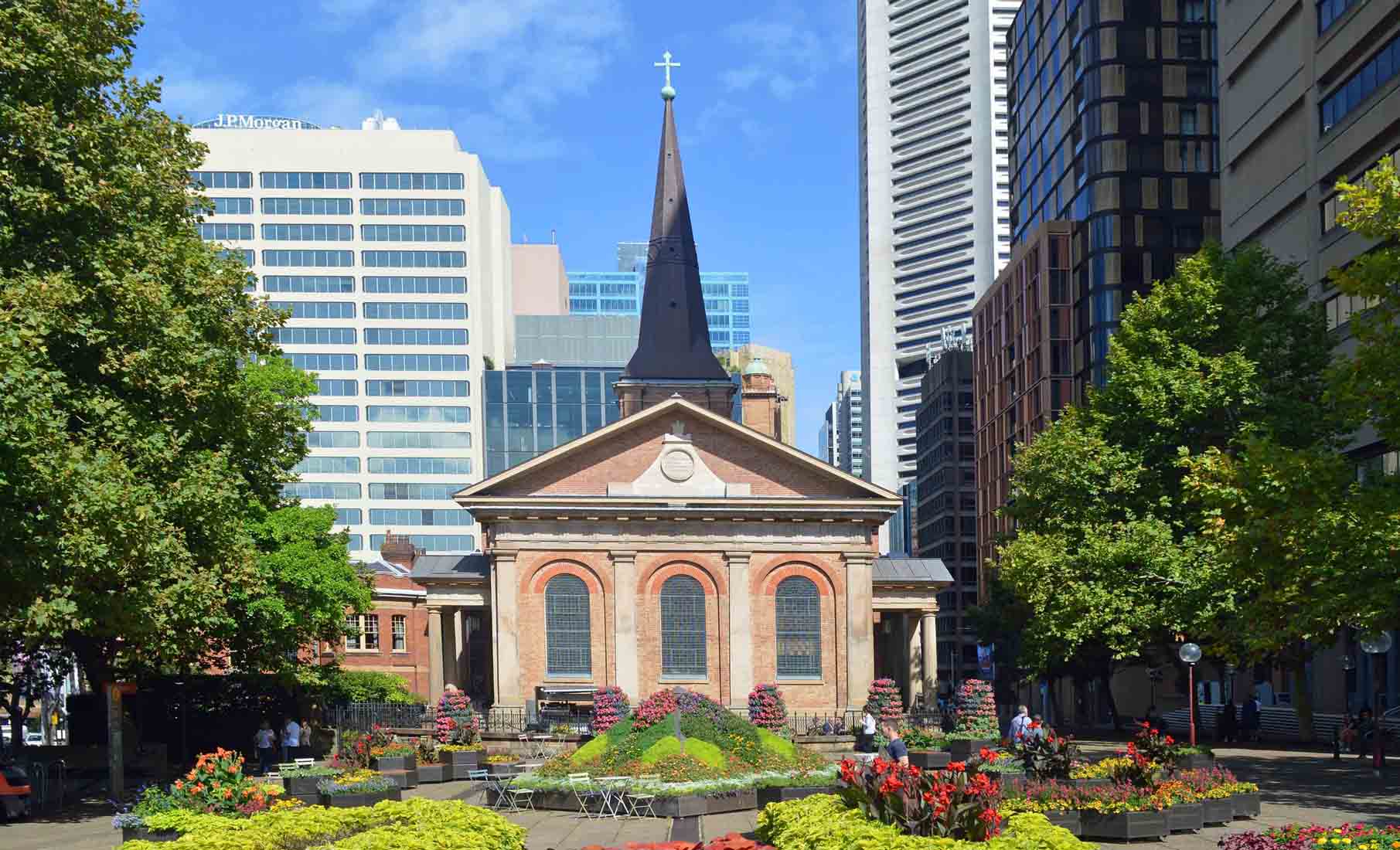ST JAMES
SYDNEY, NSW ANGLICAN
PAUL SCOTT

Our satellite view shows the historic St James’ Anglican Church bounded by King Street, Maquarie Street and St James’ Road. St James’ Road actually curves around the northern edge of Hyde Park. We notice too the Queen Victoria statue, and St James’ Square, which at the time of my visit had been transformed into a beautiful garden with a great number of planter boxes. I notice that St James’ Square appears to be the western half of Queen’s Square.
The Church itself has an east-west geographical orientation, which coincides almost exactly with the liturgical orientation used on this site (North, South, East, West with capital letters, and the sanctuary pointing in the Easterly direction).
The Church is rectangular in shape with a Western square tower rising above a narthex, a rectangular sanctuary extension at the East end, and small North and South porticoes. The building abuts the Law Court on the South side, and is close to other city buildings to the West.
Following King Street to the west quickly brings us to the city centre.
In our exploration of St James’ Church, we approach from Hyde Park to the south, follow around past St James’ Square in an anticlockwise direction, to the base of the tower. We shall then briefly examine the crypt which runs the full length of the Church, before returning to the entry at the North side of the tower.

PLAN
It is hard to find a ‘nice’ plan of St James: this plan is taken from an information sheet within the Church.
Some comments about the plan ... . The entry at the West (bottom) end leads to an attractive foyer or narthex, and here we shall find a baptismal font. The long nave has an extensive upstairs balcony at the West end. The transepts are not true transepts, but smaller extensions emerging from below the main nave roof line. The North transept (at left) is an access door to / from the nave. We shall find that the South transept is a very interesting chapel. At the East end is a chancel / sanctuary. Internally, the sanctuary appears to be housed in an apse, but this is not visible from the exterior.
On either side of the sanctuary there is a substantial wooden structure designed to support a great array of organ pipes. Unfortunately, at the time of my visit, the Church was in the process of installing a new pipe organ, so none of these pipes were to be seen!! I shall have to return again at a later date!
Monuments
There are a great number of monuments in this Church – over 300. These have little to do with the Church’s Christian ministry, but are undeniably part of the historic fabric of the building. Also, these monuments are an important historical resource about the life and times of early NSW. I have therefore chosen to include here summary details of all the major memorials, including at least the person’s name and date of death. Inclusion of these details will enable easy online follow up for various individuals, and will also enable the easy location of particular memorials by computer search.
A brief history of the Church is given below. However, if you want to begin your tour of St James’ Church immediately, tap / click on START . You can also access intermediate points in the tour by a tap / click on the following links:
HISTORY
[Wikipedia]
St James’ Church, commonly known as St James’, King Street, is an Australian heritage-listed Anglican parish church located at 173 King Street, in the Sydney central business district in New South Wales. Consecrated in February 1824 and named in honour of St James the Great, it became a parish church in 1835. Designed in the style of a Georgian town church by the transported convict architect Francis Greenway during the governorship of Lachlan Macquarie, St James’ is part of the historical precinct of Macquarie Street which includes other early colonial era buildings such as the World Heritage listed Hyde Park Barracks.
The church remains historically, socially and architecturally significant. The building is the oldest one extant in Sydney's inner city region. It was added to the New South Wales State Heritage Register on 3 September 2004, and was listed on the (now defunct) Register of the National Estate.
The church has maintained its special role in the city’s religious, civic and musical life as well as its close associations with the city's legal and medical professions through its proximity to the law courts and Sydney Hospital. Its original ministry was to the convict population of Sydney and it has continued to serve the city’s poor and needy in succeeding centuries.
Worship at St James’ is in a style commonly found in the High Church and moderate Anglo-Catholic traditions of Anglicanism. It maintains the traditions of Anglican church music, with a robed choir singing psalms, anthems and responses in contrast to the great majority of churches in the Anglican Diocese of Sydney where services are generally celebrated in styles associated with Low Church and Evangelical Christian practices. The teaching at St James’ has a more liberal perspective than most churches in the diocese on issues of gender and the ordination of women.
St James’ Church is located at 173 King Street, Sydney, in the legal and commercial district, near Hyde Park and adjoining Queen’s Square, adjacent to the Greenway Wing of the Supreme Court of New South Wales. The Church forms part of a group of notable colonial buildings along Macquarie Street, which runs from Queen’s Square to Sydney Harbour. At the time of construction, the Church and the buildings nearby were ‘Sydney's most distinguished structures ... on the highest ground, and, socially speaking, in the best part of the city’.
The geographical parish of St James’ is one of the 57 parishes of Cumberland County, New South Wales, and it initially shared responsibility for an area that extended as far as Sydney Heads. St James’ acquired its own parish in 1835. Its boundaries have since remained essentially unchanged.
The underground St James’ railway station is named after the Church. The precinct around the church is informally known as St James’.
A detailed history of St James’ Church can be found here:
https://en.wikipedia.org/wiki/St_James%27_Church,_Sydney



